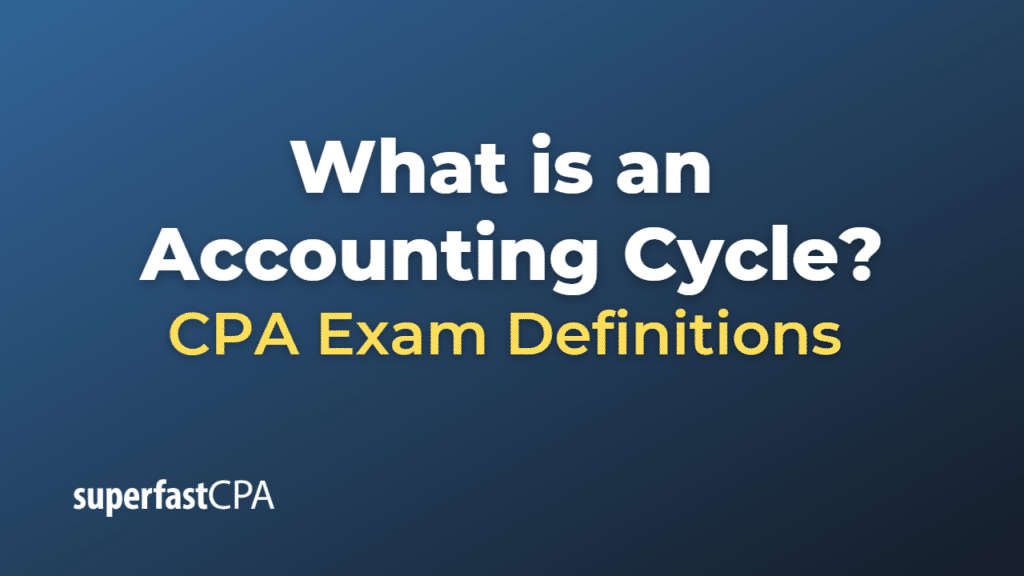Accounting Cycle
The accounting cycle is a series of steps performed by businesses during a specific accounting period to record, classify, summarize, and communicate financial transactions and events. The cycle starts with the identification of transactions and ends with the preparation of financial statements and closing of temporary accounts. The accounting cycle provides a systematic and organized approach to maintaining accurate financial records and ensuring that a company’s financial statements are in compliance with generally accepted accounting principles (GAAP).
The accounting cycle typically includes the following steps:
- Identify and analyze transactions: Financial transactions and events, such as sales, purchases, and expenses, are identified and analyzed to determine their impact on the company’s financial position.
- Record transactions in the general journal: Transactions are recorded in the general journal using double-entry bookkeeping, with each transaction affecting at least two accounts (one debited and one credited).
- Post journal entries to the general ledger: The journal entries are then posted to the appropriate accounts in the general ledger, which is a summary of all the company’s financial accounts.
- Prepare a trial balance: A trial balance is prepared by listing all the general ledger accounts and their respective balances (either debit or credit) at a specific point in time. The trial balance helps to check the accuracy of the recorded transactions and ensures that the total debits equal the total credits.
- Make adjusting entries: Adjusting entries are recorded to account for accrued revenues, accrued expenses, deferred revenues, deferred expenses, and depreciation, ensuring that the financial statements adhere to the accrual basis of accounting.
- Prepare an adjusted trial balance: After recording the adjusting entries, an adjusted trial balance is prepared to ensure that the total debits still equal the total credits.
- Prepare financial statements: The adjusted trial balance is used to prepare the financial statements, including the income statement, the statement of retained earnings, the balance sheet, and the statement of cash flows.
- Close temporary accounts: Temporary accounts, such as revenue, expense, and dividend accounts, are closed to the retained earnings account at the end of the accounting period. This step resets the temporary accounts’ balances to zero and prepares them for the next accounting period.
- Prepare a post-closing trial balance: After closing the temporary accounts, a post-closing trial balance is prepared to verify that the total debits still equal the total credits for the permanent accounts.
The accounting cycle repeats for each accounting period (e.g., monthly, quarterly, or annually), ensuring that the company’s financial records are accurate, complete, and up-to-date. The accounting cycle is a fundamental concept in financial accounting and provides a framework for managing and reporting a company’s financial information.
Example of an Accounting Cycle
Let’s consider a fictional example of a small retail store called “Cozy Corner” to illustrate the steps of the accounting cycle.
- Identify and analyze transactions: Cozy Corner identifies various financial transactions during the month, such as sales, inventory purchases, salary payments, and utility expenses.
- Record transactions in the general journal: Cozy Corner records each transaction in the general journal using double-entry bookkeeping. For example, when the store records a sale, it debits Cash (or Accounts Receivable, if the sale is on credit) and credits Sales Revenue. Simultaneously, it records the cost of goods sold by debiting Cost of Goods Sold and crediting Inventory.
- Post journal entries to the general ledger: Cozy Corner posts each journal entry to the corresponding accounts in the general ledger.
- Prepare a trial balance: At the end of the month, Cozy Corner prepares a trial balance listing all general ledger accounts and their respective balances, ensuring that the total debits equal the total credits.
- Make adjusting entries: Cozy Corner records adjusting entries for items such as accrued wages for employees, unearned revenue for gift cards sold, and depreciation on store fixtures.
- Prepare an adjusted trial balance: After making the adjusting entries, Cozy Corner prepares an adjusted trial balance to confirm that the total debits still equal the total credits.
- Prepare financial statements: Cozy Corner uses the adjusted trial balance to prepare its financial statements, including the income statement, the statement of retained earnings, the balance sheet, and the statement of cash flows.
- Close temporary accounts: Cozy Corner closes its temporary accounts (e.g., Sales Revenue, Cost of Goods Sold, Wage Expense, and Depreciation Expense) to the retained earnings account. This step resets the temporary accounts’ balances to zero, ready for the next accounting period.
- Prepare a post-closing trial balance: Finally, Cozy Corner prepares a post-closing trial balance to verify that the total debits still equal the total credits for the permanent accounts.
In this example, Cozy Corner follows the accounting cycle to systematically record, classify, summarize, and report its financial transactions and events during the month. By adhering to the accounting cycle, Cozy Corner ensures that its financial records are accurate, complete, and compliant with generally accepted accounting principles (GAAP).













